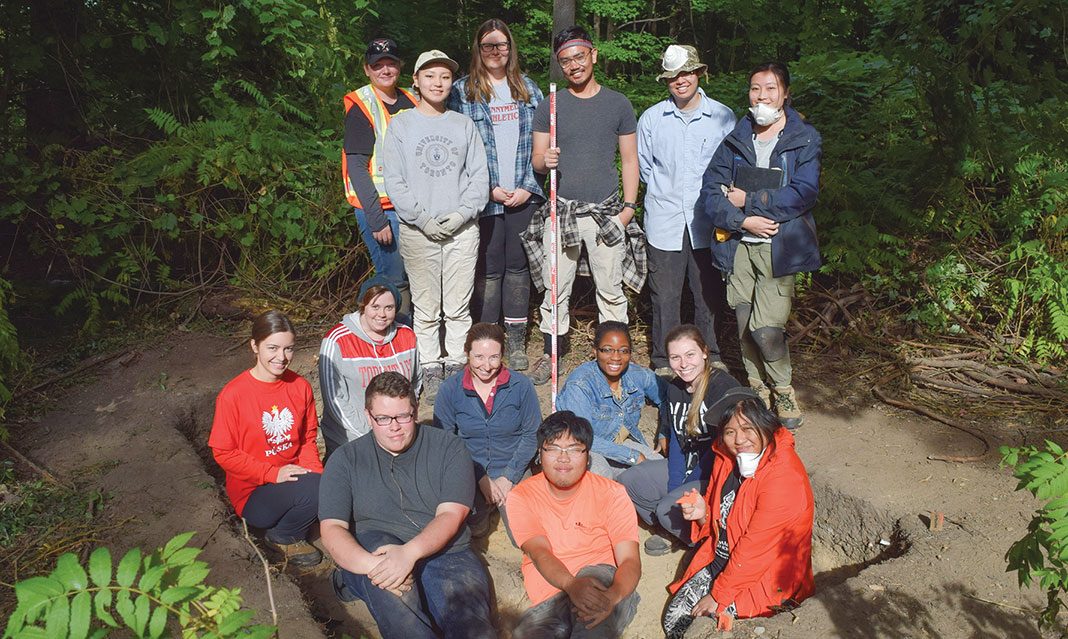The grounds near the shrubs and lengthy trees of Lislehurst—more commonly known as the vice-president’s and principal’s residence—serve as the site for this year’s UTM’s archaeological field school. This site is where third-year anthropology students at UTM apply their knowledge from the classroom to the fields.
Courses ANT318 and ANT418 serve as hands-on learning environments for students wanting to experience handling real life excavations. The course is run through late August to the rest of the subsequent semester under professor Michael Brand.
A fourth-year anthropology and biology major, Caroline Wojdylo, shares her experience with the course ANT318.
“This course started two weeks before the start of the school year. My experience so far is from these two weeks of field work, and from my experience, I really enjoyed it. I learned a lot of new things and new skills pertaining to excavations and archeology in general,” says Wojdylo.
In the past years, this course was done in various historical sites in Ontario. But this year, because of UTM’s 50th anniversary, the faculty decided to have the campus itself as a site of exploration and learning.
According to a previous article published about the course in The New York Times, professor Brand had suspected that the wooded area near Lislehurst was once the site of Mount Woodham, which was one of the three homes built by the Schreiber family on the property now owned by the University of Toronto.
One of the goals of the course is to help document the lands that make up UTM as the school approaches its 50th anniversary. It is also to provide an understanding on how communities developed in early Ontario. Through these courses, students enrolled in ANT318 and ANT418 will work on locating Mount Woodham with the investigative tools and evaluations provided by the courses.
“During all our field work, we made a lot of field notes, as we had all our notebooks and we had to record information on terrain, weather, task, crew, and the times and what we did. We also did photography and mapping […] and we learned how to recognize features from the cultural landscape […] and really learned how to think critically about what we were seeing and […] practical experience in the field really helped with that,” says Wojdylo.
Wojdylo recalls marking off a 5×5 meter square grid on the excavation site and then digging up a 1×1 meter surface from the site and mentions how once the two weeks in late August ended, the students went back to their lab to analyze the history behind their discoveries.
“We dug down until we reached sub soil, sterile soil, so that was probably the most intense, but it was also really fun as it was the part where everyone wanted to get to because it was the most fun [part] of the excavation, ” says Wojdylo.
One of the most memorable moments that Wojdylo recalls while performing field work for the ANT318 course was discovering a fully intact 19th century child’s toy that was a metal horse with a solider riding it.
“We also found a spoon, we found [….] a lot of glass and a lot of rusted metal sheets and curved parts and a lot of different nails, like old nails. And in the lecture we actually analyzed the different types of nails as you move through history […] We also found some porcelain pieces, some ceramic, some bottlenecks, presumably bottle necks, […..] which indicates some human activity in the past,” explains Wojdylo.
As students learn archaeological excavation techniques through the course, Wojdylo mentions how, while the outdoor instruction was both beneficial and enjoyable, the most rewarding experience was experiencing history as she says “the most intriguing thing was asking yourself—what were people doing here 150 years ago?”



